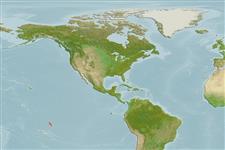Classification / Names
Common names | Synonyms | Catalog of Fishes (gen., sp.) | ITIS | CoL | WoRMS | Cloffa
Actinopterygii (ray-finned fishes) >
Perciformes (Perch-likes) >
Serranidae (Sea basses: groupers and fairy basslets) > Anthiinae
Etymology: Pseudanthias: Greek, pseudes = false + Greek, anthias = a fish, Sparus aurata (Ref. 45335); hiva: Named for Marshall Is. (old Polynesian name is believed to be 'hiva'); noun in apposition.. More on author: Randall.
Environment / Climate / Range
Ecology
Marine; reef-associated; depth range 10 - 34 m (Ref. 48242). Tropical, preferred ?
Eastern Central Pacific: Marquesas Islands.
Size / Weight / Age
Maturity: Lm ? range ? - ? cm
Max length : 10.0 cm SL male/unsexed; (Ref. 48242); 6.0 cm SL (female)
Dorsal
spines
(total): 10;
Dorsal
soft rays
(total): 17;
Anal
spines: 3;
Anal
soft rays: 7;
Vertebrae: 26. Body depth 3-3.2 in SL; head length 3=3.2 in SL. No papillae on posterior edge of orbit. Front of upper lip of males without a prominent fleshy protuberance. Tenth dorsal spine longest, 2.05-2.3 in HL. Color of females orange shading to pink ventrally, the scales dorsally on body with dusky yellow centers, those ventrally with yellow; a narrow orange red bar on body below 8th dorsal spine ; a yellow-orange band, bordered below by violet, from lower part of eye to pectoral-fin base; dorsal fin orange with a violet margin; front half of anal fin magenta with a violet margin, the posterior half yellow, the lobe tips bright red. Color of body of males lavender-red dorsally, shading to pale lavender ventrally, the scales below lateral line with yellow centers; head orange-red above a bluish white line from lower edge of orbit to lower base of pectoral fin, pale orange below; dorsal fin translucent orange-yellow with a lavender margin; anal fin translucent lavender with a row of small yellow spots on membranes; caudal fin red, the upper and lower edges and filaments pink; pelvic fins light red. Scales above lateral line to 2nd dorsal spine 6, middle dorsal spines 3.5 (Ref. 48242).
Specimens collected over rocky substrata, usually at depths greater than 25 m; with the use of rotenone and quinaldine (Ref. 48242). Feeds on zooplankton (Ref. 89972).
Life cycle and mating behavior
Maturity | Reproduction | Spawning | Eggs | Fecundity | Larvae
Randall, J.E. and R.L. Pyle, 2001. Four new serranid fishes of the anthiine genus Pseudanthias from the South Pacific. Raffles Bull. Zool. 49(1):19-34. (Ref. 48242)
IUCN Red List Status (Ref. 115185)
CITES (Ref. 94142)
Not Evaluated
Threat to humans
Harmless
Human uses
More information
Common namesSynonymsMetabolismPredatorsEcotoxicologyReproductionMaturitySpawningFecundityEggsEgg development
ReferencesAquacultureAquaculture profileStrainsGeneticsAllele frequenciesHeritabilityDiseasesProcessingMass conversion
Tools
Special reports
Download XML
Internet sources
